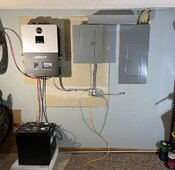I kept going back and forth on this (transfer switch vs. critical loads) for my 2 x 6000XP's. While my needs are a little different than yours, one of my primary concerns includes the ability to isolate or bypass the inverters as needed...whether that's for maintenance or an emergency. And considering the system is at a cabin 2.5hrs away, I needed it to be as easy as possible for someone else to flip a switch.
My solution was to first combine the AC output of the 2 inverters then provide a switch to toggle
all loads between grid and PV. There are a handful of ways to accomplish this, but I ended up breaking everything out to provide the greatest amount of flexibility. In the end, my system closely resembles this clear diagram by
@FilterGuy:
Sorry if I'm being slow this morning. ;) So we would need two of these switches - one for each of the 120V phases, or it can be done with just the one? Does this help? Edit: Corrected diagram to show ground to the 100A bypass switch. BTW: The diagram shows one ground wire with branches...

diysolarforum.com
(post #80 on that thread shows a single-inverter example)
Something about that design just clicked and helped make sense of a lot of my initial questions...kudos to
@FilterGuy for that!




